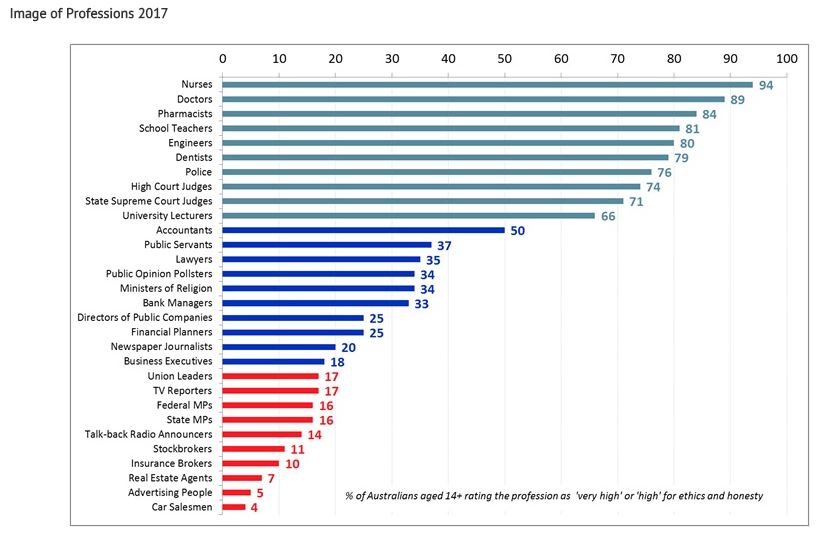I think we need to start looking in the mirror and asking ourselves why…
Some of the ratings were troubling indeed! For example, it looks like the Ministers of Religion took a bit of a hit, along with Union Leaders and Politicians, however it was right down in the red section where we find Advertisers lumped alongside the usual mob of car salesmen, Real Estate Agents and brokers. When I say ‘usual’, I mean because they are the same usual suspects at the bottom end of the scale, year after year.
You can view the article, here: http://www.roymorgan.com/findings/7244-roy-morgan-image-of-professions-may-2017-201706051543
So what’s happening out there?
As this is a general survey, it would be safe to assume that the “Advertising People” category encompasses Marketing professionals and anyone else directly involved with pushing profit making messages.
What does that say about Marketing?
Well, it’s pretty obvious! Your customer is fed up with being screamed at by all of the above-the-line techniques. This is why more subtler channels like blogs, social media and PR campaigns are far more effective these days- as people like doing their own research and coming to their own conclusions about their purchasing behaviour before they make a move as opposed to expensive mass media adverts.
Customer behaviour has evolved to empowerment and education. We as Marketers need to ensure we are providing engaging content which allows them to come to their own decision. If our product is worth it, they will come; which is an added incentive to be the best in the market.
How do we improve our reputation?
Caring about our customers and the public in general. Adopting the Empathetic Marketing approach is the way forward for our industry, which means providing caring infomation to empower people, rather than manipulating them, talking down to them or ‘click bating’ them.
See my blog here about Re-Humanising Marketing: www.melottimedia.com.au/blog/the-road-to-re-humanising-marketing
With technology rapidly interconnecting global societies, and our lives racing at an even faster speed than ever before, it’s becoming obvious that today’s Marketing efforts as a whole are failing to evolve in sync with such a pace, which has meant that our target audiences are becoming increasingly resistant and more elusive when exposed to our ‘same-old’ practises.
Marketing In The New Era: The Difference Between Marketing and Advertising
All advertising is marketing, but not all marketing is advertising. If you and your organisation see it as the same, then now is the time to rethink your marketing efforts. Basically, it means that you’re opening up a box of crayons (“marketing”), and trying to create a colourful masterpiece with only one colour (“advertising”), then wondering why the canvas is lackluster and not attracting interested buyers.
The other day, one of my house mates said to me, “as a marketer, your industry is dying because I just ignore all advertising now, and I don’t think I’m alone.” This is quite an interesting statement as he was highlighting the very misconception between marketing and advertising.
Marketing is an all-encompassing, essential practise, which includes elements such as organisational strategy, customer research, trend investigation, public relations, social media promotion, product design, pricing techniques, promotional campaign activities, distribution management, demographic analysis, positioning, competitor research, innovation, concept design, bundling, content creation, copywriting, and so on. All of these efforts need to be working together to build a successful organisation.
It’s understandable where all of this confusion has emerged about what marketing actually. Advertising is really the only highly overt form of marketing which everyone actively notices. It’s called ‘above-the-line’ and is the promoting of brand awareness to a large target audience via mass media, such as television, print and radio. My house mate was half right: the traditional mass advertising trend is starting to become ineffective, because consumers are so utterly bombarded now that they are learning to automatically filter out messages of no interest to them.
The practise of marketing is very different these days, with organisations shifting away from just advertising, and towards what I call Empathetic Marketing: developing a strategy that focuses on catering to the human person. Advertising is all about forcing messages onto a potential customers, but other methods of marketing are now far more effective and consumer friendly. Organisational blogging is a way to reach people with general content that engages them in a less intrusive way. PR activities draw people in, encourage their feedback by joining in on the conversation, thus creating highly coveted word-of-mouth. Podcasting is usually free and enjoyable for people to listen to at their convenience, and if scripted well, will gain a following of consumers that actively download each episode and end up as an advocate. Social media connects consumers to each other and offers advice and opens forums, thus easing the barriers to purchase.
Today’s consumers expect more than noisy, forceful messages. They want to be catered to, appreciated, wooed and persuaded. They distrust forceful messaging, and look to other, more trustworthy sources that essentially are other angles of marketing. This doesn’t mean that you can use marketing to manipulate them in more subtle ways, as that’s not true. Today, people are highly educated and informed, and are extremely judgmental about these channels, so effective marketing requires high quality efforts. Poor campaigns and uninspired campaigns will surely fail.
Today’s marketing channels are new, innovative, fluid and highly digital, and so marketing efforts must reflect this, offering the consumer engagement, information, and interactive advice. The key to successful marketing is to value your customers; engage with them, offer them advice, respond, invest your time in them and customise your offering to them, so that their experience is ultimately unique and rewarding. This is not simply recommended, it is essential as your target audience now expect it. There are too many competitors out there waiting for your organisation to ‘drop the ball’.
Marketing is no longer about forcing advertising down a customer’s throat; it’s about getting to know your customer and being interested in what they really want, their preferences and opening communication in order to build relationships. Think carefully about them and how your product or service will benefit them and then actively engage with them to demonstrate your empathetic marketing.
Christopher Melotti
www.melottimedia.com.au






